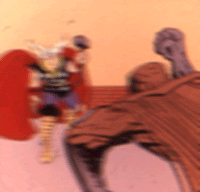 |  |
![]()
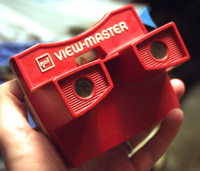 No, I had a Viewmaster -- that's it, in the picture there. A GAF version, classic 1970s. It still works OK, having been repaired more than once. I never saw the image because until I got my glasses I didn't really see all that well. My eyes had never been trained to focus that way. Binoculars, too -- never worked. Blue/red 3D glasses? Nuh uh. Those Seeing Eye "cross 'em until you see the sailboat" pictures? I thought they were a joke played on me. I couldn't get it. In high school, after I'd adjusted to seeing more than 50 feet in any direction, I began to figure out how to use these old toys, and I was amazed -- they could put little 3D images in there! I couldn't believe I'd missed out on this. As I've mentioned before, our family motto was: "Throw it out? It's still good!" so pretty much all my old Viewmaster stuff survived through the years.  A while back I saw Jim Gasperini's technique for showing stereo photos online, using animated GIFs, and when I dug out my Viewmaster I realized the technique would work here, too. In fact, it shows a lot about the technique used to create the reels. 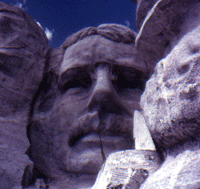
A487 - Mount Rushmore National Memorial (1962)  They actually used 3D cameras, specially designed machines with two lenses. They were separated the approximate distance to imitate the human eye, and captured two simultaneous images, side-by-side. But, because they're fixed objects, sometimes (like the closeup of the indian), the separation can be headache-inducing. However, this was the way a lot of people saw the sights of the world, or bought to document their travels. Without these and their wide appeal, there probably wouldn't have been a Viewmaster at all. 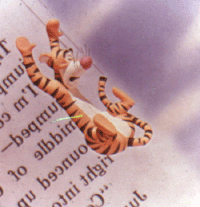
B369 - Winnie the Pooh & Tigger Too (1977) 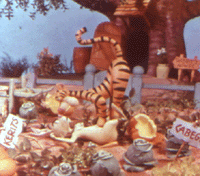 I'd love to find out where these dioramas are now...but I'll bet I'd have to dig through the landfill to find them. Enormous detail went into creating these mini works of art, simply to be photographed for Viewmaster reels. Many different reels used them, some cartoons, some informational (like the dinosaurs above). The Ultimate Viewmaster Reel List indicates which were dioramas and which weren't, if you're making a shopping list. 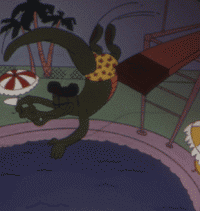
Set B509 - Space Mouse, Wally Gator, and Knothead & Splinter (1964) 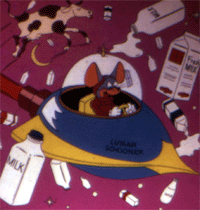 Look at all the small details in the Space Mouse image -- and this was done pre-computers. They couldn't stick all this into the 3D renderer and tell it to pop out a left and a right. Even if the objects were drawn separately, they had to be laid out by hand in the proper places to show depth. Even the Scooby Doo artists didn't bother coming up with original art. It's a symbol of the Viewmaster heyday of the 1960s -- the reels had a degree of value, and the workmanship paid off in it. Let's see you try it: draw a simple picture. Now, draw an identical one, but rotate it figuring 1/50th of the distance from you to the object. Granted, these artists were cartoonists, probably even worked for Walter Lantz at the time, and were accustomed to drawing in the three dimensions. That they took the time to draw the Viewmaster for the medium, it proves their talent. 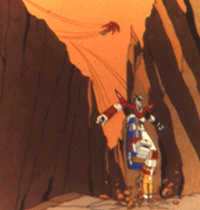
1055 - Voltron (1984) 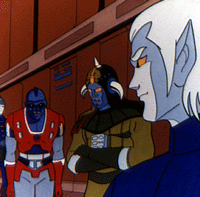 But why Voltron? The quality of the art makes it seem done by the original artists, but the original artists were Japanese anime cartoonists. When you consider the amount of space viewed in the hallway view, above, there's no way it was drawn for television and adapted. The hallway background had to have been 2 or 3 frame widths to fit into both images, including what I had to crop to make it interesting for online viewing. Unfortunately, much of the time, the reels were made from existing images and altered for a pseudo-3D effect. 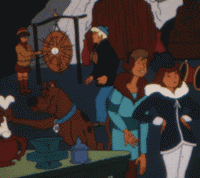
B553 - Scooby Doo, "That's Snow Ghost" (1972)
H39 - Thor "The Wrath of Odin" (1977) A rather lame attempt at 3D. Mostly cutout (with some perspective changes by altering width of the reproduction). The art is faithful to the Jack Kirby art, and may even be taken directly from a comic. 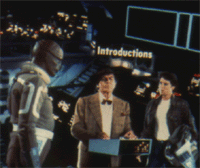
4057 - The Last Starfighter (1984) 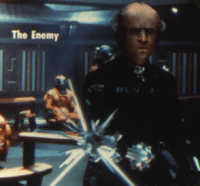 Although, someone got a great idea: they'd include nearby frames from the movie that are from slightly different angles from each other. The camera moved, the person turned, they could still squeeze some 3D from the flat film. Watch the weapon's arms in the frame above. They move slightly, because they're from different frames in the movie. Still, it didn't counteract the poor quality of the 3D separation, making it difficult to line frames up in your eyes. 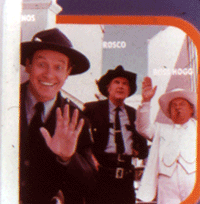
L17 - The Dukes of Hazzard (1980?) 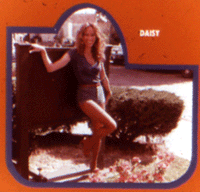 ...and who could pass up the change to see Daisy in 3D? It seems that the photographer had full access to the actors and sets; the reels look posed & arranged for the Viewmaster. It's not like they allowed the cameraman to take pictures as they filmed; these cast photos were arranged for the camera. 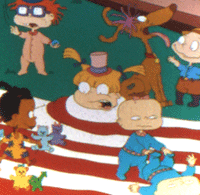
31099 - RugRats "Circus Angelicus" (1997) 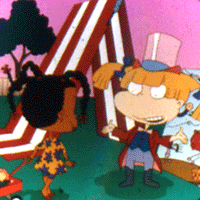 The RugRats frames are nicely done, drawn separately with stereo perspective. With the age of computers, I could write it off as 3D animation, but I'd hope that RugRats was still drawn by hand for this reel. They still make Viewmasters, you know. Mostly, they're promotional items, packaged as 'gift boxes ' with the sponsor's show as a theme. In other places, they're used as 3D samples -- the book Anatomy of the Temporal Bone with Surgical Implications includes 3 Viewmaster reels of both normal and pathological findings. While that's probably not as cool as Voltron, it's nice to know that such a simple technology still has it's place. 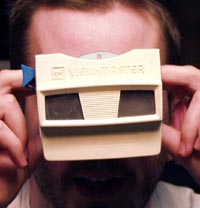
|


